Choosing your favorite camera is not an easy task. Much like parents who have more than one child, picking which one you like better isn’t an easy thing to do. Thankfully, much like parenting, there’s no reason you can’t have two favorite cameras. But this is the Internet and people like favorites, so I decided to torture myself and put a metaphorical gun to my head and pick between two of my all time favorite 35mm SLRs.
The two cameras below have been in my collection for a very long time and I’ve hesitated writing about them as it’s hard to give a fair review to something if you already love it. The Nikon EL2 was my first ever 35mm SLR back before I had any intention of starting this site and the Minolta XE-7 came a couple years later, but quickly endeared itself to me much in the same way.
Although this wasn’t intentional, it is a coincidence that two of my all time favorite 35mm SLRs both happen to be from the same era, and possibly even competed with each other in photography shops when they were still current models. The Minolta is the older of the two models, being sold from 1974 – 1977 and the Nikon for only two years in 1977 and 1978. Both cameras are auto exposure electronic cameras that upon the time of their release were technologically advanced and expensive cameras that would have been only a small step down from both company’s professional level cameras.
I guess I have a fondness for this era of camera with these features. Knowing their similarities, how do they differ, and now that I’m forcing to choose, which one is my favorite?
Let’s start with some specs. As you can see, both cameras share a lot in common. But as we all know, the greatness (or weakness) of a camera often has little to nothing to do with it’s specifications.
Lens Selection
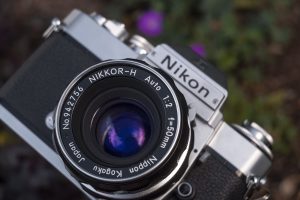
One area in which we’re not likely to see a huge difference between the two cameras is in lens selection as both Minolta and Nippon Kogaku (as they were called at the time), each were well respected optical lens makers and had a huge selection of lenses available to them. Although each of these models were released in the 1970s, both used a lens mount that had originated in the late 1950s and with only a few exceptions, could accept any lens made for previous models.
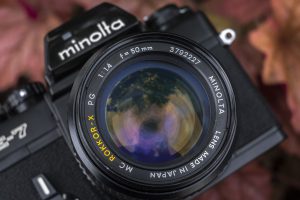
The EL2 uses the Nikon F bayonet mount and the XE-7 uses the Minolta MC bayonet mount. Both mounts are large, three claw mounts that are easy to put on and take off. You could get lenses in pretty much any focal length you wanted, even zooms, and the standard kit lenses were considered to be the best of what money could buy at the times they went on sale.
Sure, there might be one or two specialty lenses available to one system but not the other, but I don’t think it’s fair to make a determination on one or two obscure lenses that 99% of people would never use.
It did not matter which lens you have mounted to either camera, this is not an area where you will see a difference between either model.
Winner: Tie
Features
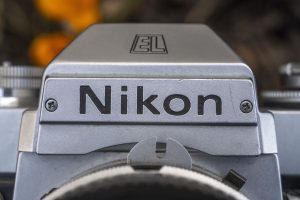
Both the XE-7 and EL2 were advanced models with a long list of features when they were first released. Japanese companies like Minolta and Nippon Kogaku would often release new features in mid level products first, before including them in their professional series cameras as a sort of trial run to see how the features performed and stood up to every day use before adding them to their “bread and butter” cameras.
Both cameras have TTL Aperture Priority Auto Exposure with a stepless electronic shutter, fixed pentaprisms with metering information visible in the viewfinder, a self-timer, depth of field preview, and both have a flash hot shoe with support for older flashbulbs.
The Minolta XE-7 bests the Nikon in a couple of areas, featuring an aperture readout in the viewfinder that the Nikon doesn’t have, a clever double exposure lever, and it also has a convenient film transport indicator on the back plate of the camera. The Nikon EL2 however, has a motor drive coupling which allows the Nikon AW-1 to be added for up to 2 continuous frames per second, has a mirror lockup feature, AE lock, and has a more advanced and faster responding Silicon Blue Cell exposure meter, as opposed to the older and slower CdS meter in the Minolta XE-7.
None of these differences are deal breakers as most photographers in these segments probably wouldn’t have wanted a motor drive or mirror lockup, but it’s worth mentioning though since features do sell, and the Nikon EL2 gets a slight edge here.
Winner: Nikon EL2

Shutter
Both cameras have a vertically traveling Copal Square electronic shutter capable of stepless auto exposure. The Minolta being a three year older camera, has a slightly older version of the same shutter and lacks the 8 second speed of the EL2 and has a slightly slower flash sync speed. Both shutters are electromagnetically controlled allowing for a single manual speed of 1/90 with a depleted battery, and have been proven over the decades to be extremely reliable and accurate designs.
While you could say on paper the Nikon EL2 wins with one extra slow speed and a 1/125 flash sync speed, if I’m being totally honest, those are things I will never use so I can’t honestly say there’s a clear winner here. This one’s a tie as both cameras have extremely capable shutters.
Winner: Tie
Viewfinder
For most people, the usefulness of the viewfinder is an important feature, but I have terrible vision and have to wear prescription glasses when shooting, so a bright and easy to use viewfinder is critical for my enjoyment of a camera. There’s nothing worse than putting a camera up to your face and seeing a dim image, or not being able to see the corners.
The good news is that both the Nikon EL2 and Minolta XE-7 have excellent viewfinders that I had absolutely no trouble shooting. In fact, by the time each of these models were released, laser etched focusing screens had gotten to the point where brightness was so good, that as the years went on and viewfinders had LCD overlays on them to show things like focus confirmation, that they actually got darker, making the viewfinders in cameras like the XE-7 and EL2 brighter than some that came decades after.
The Minolta one-ups the Nikon in that it uses a Judas window on the front of the prism to show the selected f/stop at the top of the frame. A second window shows the selected shutter speed or an “A” in Auto mode and while this is a nice feature, it’s implementation isn’t as useful as you might think as these windows can be difficult to read in low light, and with prescription glasses, the top windows are at the extreme upper edge of what you can see while looking through the eyepiece.
Both cameras have a split image focusing aide and microprism collar around the edge for focusing, and both have an analog exposure meter scale on the side. The Nikon adds a 12mm center weighted circle which shows the area of the image the metering system averages most of it’s reading from.
Both cameras have extremely bright viewfinders, but the Nikon EL2’s Type K screen edges it out slightly, most notably at the corners where the brightness is almost exactly the same as the center. In the XE-7, there’s a subtle vignetting effect in the corners that is only really obvious in low light.
Where the Nikon EL2 really shines is in it’s double needle analog scale. With the camera in Auto mode, a green needle points to the A and a black needle shows the shutter speed that the meter will select when the shutter is fired. The Minolta can do this too, but it’s implementation is different with only a single needle, and the letter “A” appears in one of the top Judas windows.
In manual mode, however, the green needle reflects the currently chosen manual shutter speed, and the black needle points to a recommended shutter speed based on available light. Proper exposure is obtained when both the green and black needles match. If you want to intentionally add or subtract exposure, changing the green needle to be above or below the black needle will accomplish this on the fly, all without taking your eye away from the viewfinder.
The Minolta still allows these features, but it’s not as elegant as you need to rely on a combination of the black needle and the shutter speeds displayed in the top Judas window.
Both the Minolta XE-7 and Nikon EL2 have excellent viewfinders that are near or at the top of the best found in a 1970s SLR, but Nikon’s excellent Type K screen, along with it’s brilliant implementation of the dual needle meter readout (which they continued to use on the later Nikon FE and FE2), give it a slight edge.
Winner: Nikon EL2
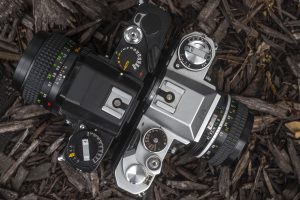
Ergonomics
In a blind test, it would be extremely difficult to tell the difference between these cameras based solely on feel. Without a lens mounted, the two cameras are almost identical in weight with the Nikon weighing only 6 grams more. The location of critical controls like the shutter release, film advance lever, and control dials is almost identical.
In addition to weight, the overall dimensions of both cameras are almost exactly the same with the Minolta being about 1-2mm wider and taller.
With nearly identical dimensions, weight, and control layout, this ones an easy tie. A novice could pick up either of these cameras an interchangeably go back and forth between either model without having to relearn it’s controls.
Winner: Tie
Reliability
While reliability is certainly a factor when determining the viability of using an old camera, it’s one that’s the hardest to measure. Over the years, cameras like the Minola X-700 or Canon T90 are not known for their ability to survive decades of disuse as their electronics often fail, resulting in unusable cameras.
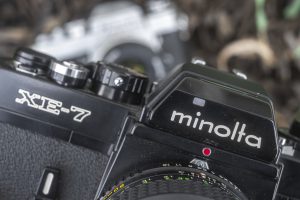
Sometimes, an entire technology has a much higher failure rate such is the case with leaf shutter SLRs where even the slightest bit of dirt or dried lube can muck up the entire camera.
Both the Nikon EL2 and Minolta XE-7 were premium cameras built with a high level of quality that while using some electronics, weren’t done to the extent of later cameras from the 80s and 90s. As such, I don’t think we can definitely declare one camera more or less reliable than others. I’ve owned four Nikon EL2s over the years and all worked, and although I have less experience with the Minolta XE-7, after surveying other collectors, this is not a camera known for failures, so I feel confident in saying that there is no measurable difference in reliability of either of these models. That doesn’t necessarily guarantee that any you find for sale can’t still have problems, just that your odds are pretty good of getting a usable example.
Winner: Tie
Performance
When it comes to SLRs, there’s very little of the camera body itself that plays a role in the quality of images. The lenses are where you’ll see any differences, and when comparing two of the most highly respected Japanese optics companies, whatever differences might exist between Nikkor and Rokkor lenses are not anything I can detect.
It’s probably pointless to compare performance of two SLRs like the Nikon EL2 and Minolta XE-7, but since people buy these things to make images, it’s worth declaring that any difference between these two models there might be, it won’t be in their ability to make great images.
Below are a sampling of 4 images taken with the EL2 and the XE-7 in random order. Apart from the one showing myself in the mirror, I highly doubt anyone would be able to guess which camera shot which images.
Winner: Tie
Price
Whenever you compare any two products, whether it’s cameras, automobiles, stereo equipment, musical instruments, or even restaurants, the amount you pay for something is the great equalizer. If you pay more for something, you should expect to get more. While both a Cadillac and a Hyundai can pick up your kids from school or drive you home from an airport, you’d expect the Cadillac to have more style, horsepower, and amenities than a more basic car.
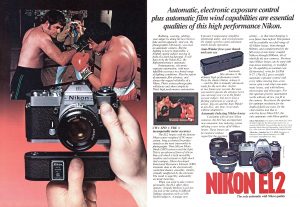
When each of these models were new, they were both expensive cameras that were likely out of the reach of the average consumer. The Nikon EL2 varied between $637.50 with a Nikkor 50mm f/2 lens and $831 with the Nikkor 55mm f/1.2 lens. When taking into account inflation, these prices compare to $2580 and $3400 today.
The Minolta XE-7 came out three years earlier selling with the f/1.4 or f/1.2 lenses for $645 and $720 respectively which when adjusted for inflation compare to $3075 and $3425.
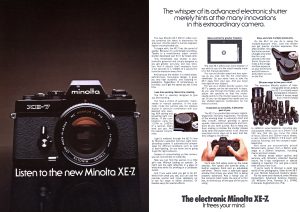
Using the prices with each camera’s f/1.2 lens option, the inflation adjusted prices are almost identical making these pretty favorable cameras to compare. Of course, these are manufacturer’s suggested prices and the actual street prices were likely much less, and by the time the EL2 was released three years after the XE-7, it probably would have cost more, but that’s not really much of a factor today.
If after reading this review, you wanted to go out and buy one of your own, your best option is eBay and the best way to judge the value of a camera on eBay is to look at sold prices. The last time I did a showdown between two cameras like this, I used an eBay price tracking website that has since gone offline, and not being able to find anything comparable, I decided to just do some searches myself.
As I write this, there are 23 Sold auctions for the Nikon EL2 and 64 for the Minolta XE-7 which makes sense as the XE-7 was in production for 4 years versus barely over a year for the EL2. I also only searched for the North American XE-7 and not the European or Japanese XE1 or XE.
I eliminated sales of cameras that came in large lots with other cameras or multiple lenses, highly desirable f/1.2 or other lenses, original packaging, or other things that would inflate the selling price of an auction and tried to look at only those for the camera body by itself or with a typical “kit lens” like an f/2 or f/1.8 lens. I also only looked at those selling in the United States so as to take out price variances in different markets, and any that were obviously parts cameras or in extremely poor condition. Doing this, I found 15 sales of the Nikon EL2 ranging in price from $12.50 to $94 and came with an average price of $48.48. For the XE-7, I looked at 33 sales ranging in price from $11.50 to $103.50 with an average price of $44.24.
Considering the almost identical inflation adjusted prices of these two models when they were new and a difference of only $4 between the average cost of actual sold examples on eBay, I don’t know that price is going to be much of a factor here. The fact that with a little bit of patience, you could pick up both of these cameras today for under $100 total means that you really should just buy them both! Imagine saying that to someone shopping for either of these two models in a 1970s camera store!
Winner: Tie
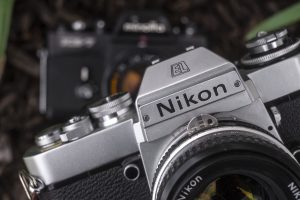
Final Conclusion
It’s one thing for me to write a post about my thoughts on an individual camera, but as soon as you start ranking them or declaring one being better than another, you risk ruffling the feathers of die hard fans of one model over another.
If I’m being truly honest, the winner in a head to head comparison between the Minolta XE-7 and Nikon EL2 is you. These are both fantastic cameras that are worth owning and shooting today. They were built by two of the best camera makers of the 20th century at a time just before the dawn of the electronic age. They have similar feature sets, reliable shutters, excellent ergonomics, and have the support of a huge range of excellent lenses. Considering you can reasonably find these cameras for under $50 on the big auction site, there’s no reason you couldn’t just own both.
With that little bit of political correctness out of the way, I’m going to declare the Nikon EL2 as my favorite. As I mentioned in that review, it is one of my all time favorite cameras by any company, ever made. And for good reason, the camera is the perfect amalgam of the classic tank like styling of Nikons of yore, but with just enough technology and advanced features that it rivals SLRs made decades later in terms of performance.
I think that for the few differences that exist between the two cameras, had the Minolta XE-7 come out three years later alongside the EL2 they might have been identical, but as it stands, the Nikon EL2’s better viewfinder with excellent two needle meter readout, and features like a motor drive coupling, AE Lock, and Mirror Lock features give it an ever so slight edge.
What do you think about my recommendation? Do you agree or disagree? Let me know in the comments section below.
External Resources
I’ve written full reviews of both the Nikon EL2 and Minolta XE-7 which can be found below, but don’t take my word for it, check out one of these other excellent reviews for both cameras.
Nikon EL2
https://www.kenrockwell.com/nikon/el2.htm
https://www.mir.com.my/rb/photography/hardwares/classics/nikkormat/elseries/el2/index.htm
https://www.678vintagecameras.ca/blog/nikonikkormat-el-nikon-el2-nikon-plugs-in8322302
http://www.photographic-hardware.info/nikon_manual_focus_slr_film_cameras/nikon_el2_camera.htm
https://www.flickr.com/groups/32237332@N00/discuss/72157631798059442/
Minolta XE-7
https://casualphotophile.com/2014/04/14/minolta-xe-7-slr-a-casual-retrospective/
http://www.alexluyckx.com/blog/index.php/2018/10/10/ccr-review-98-minolta-xe-7/
https://www.678vintagecameras.ca/blog/x-marks-the-spot-the-minolta-xe-series
https://www.photo.net/discuss/threads/minolta-xe-7-the-crown-jewel-of-the-sr-line.367065/

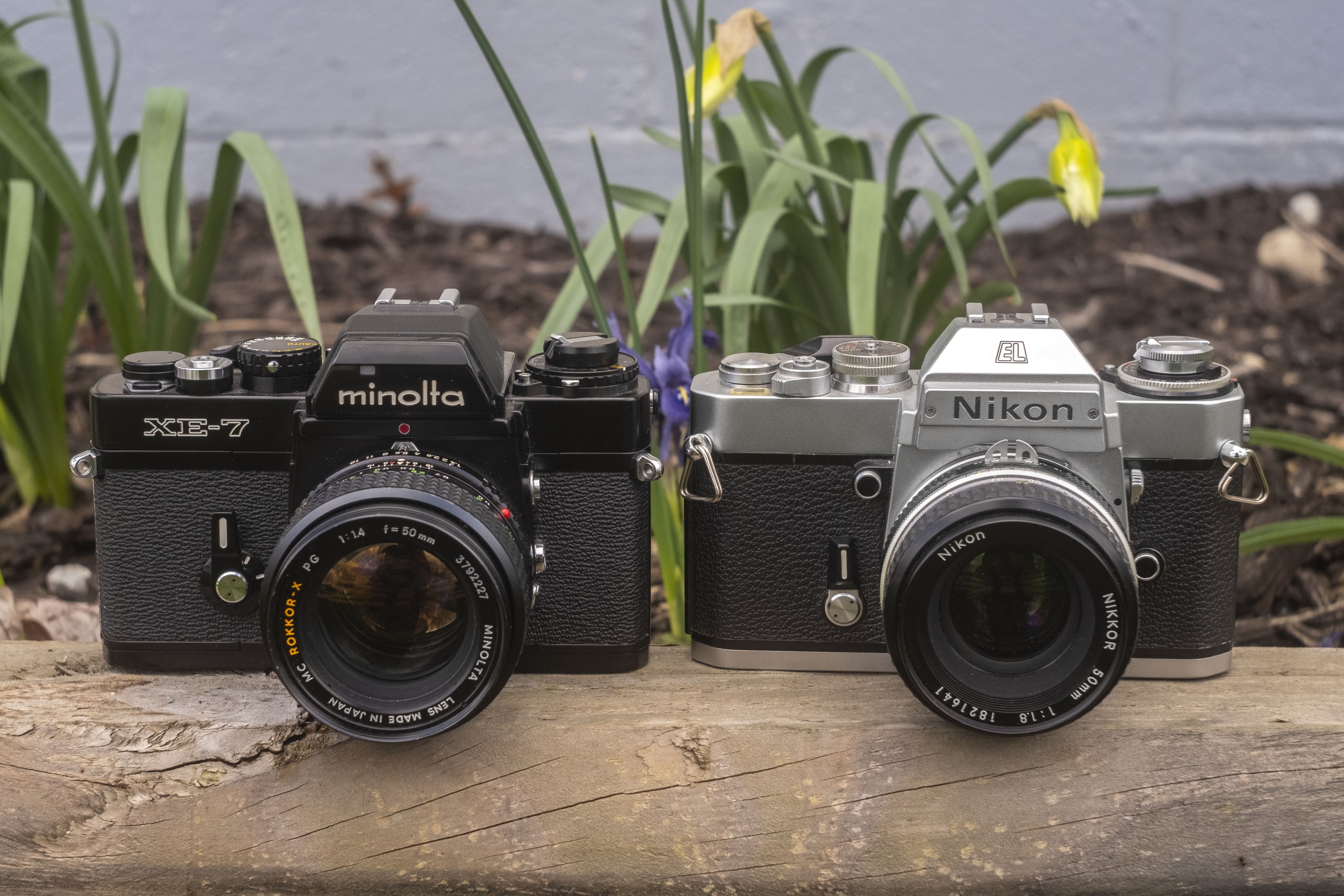

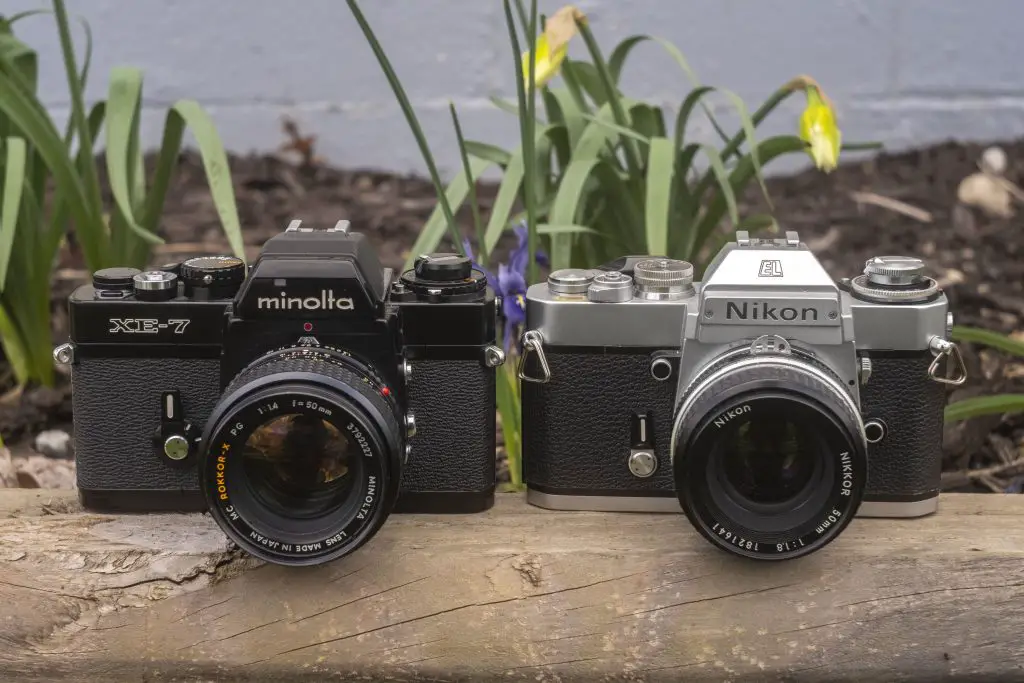
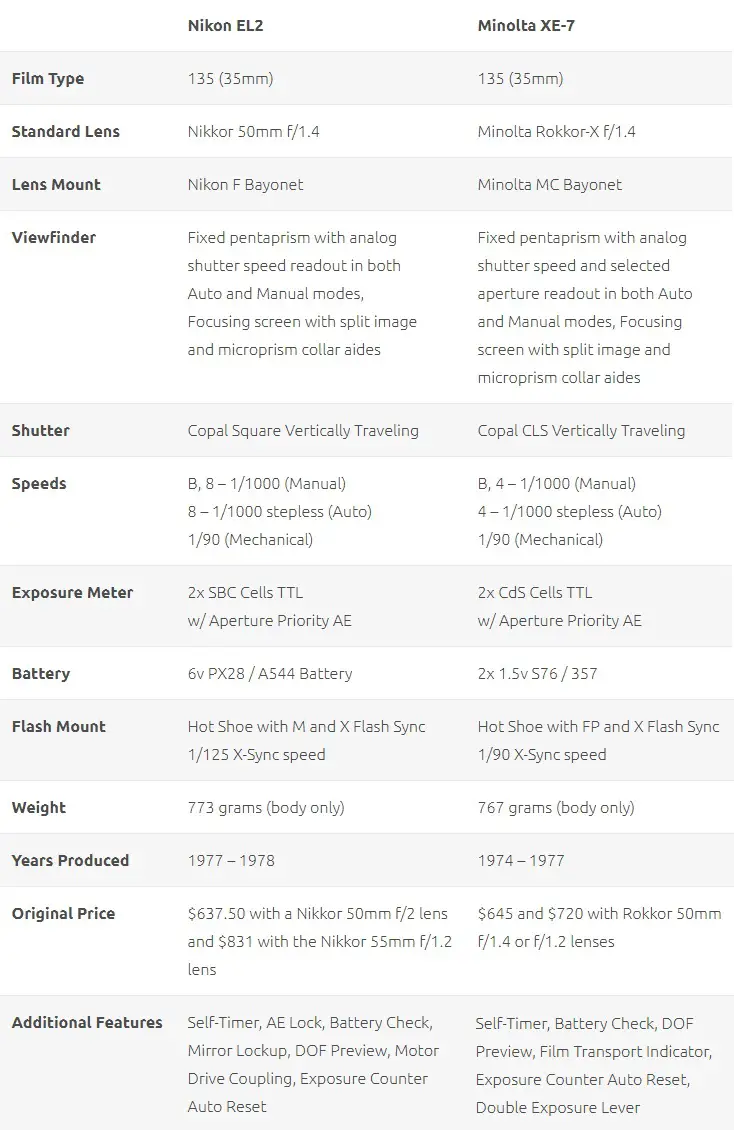
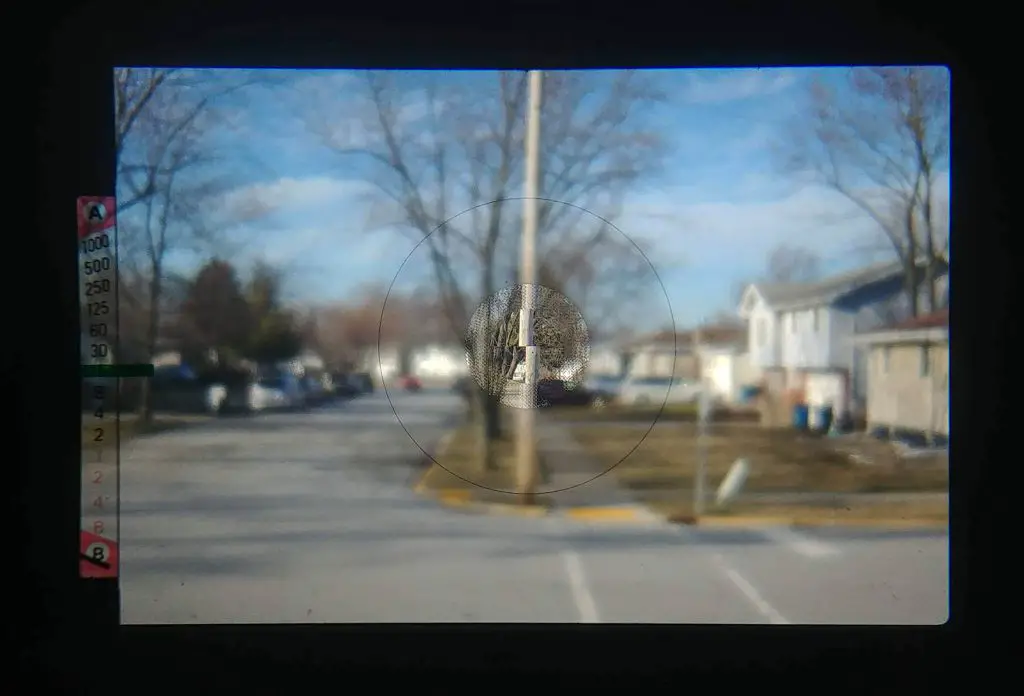

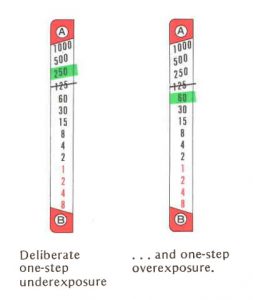









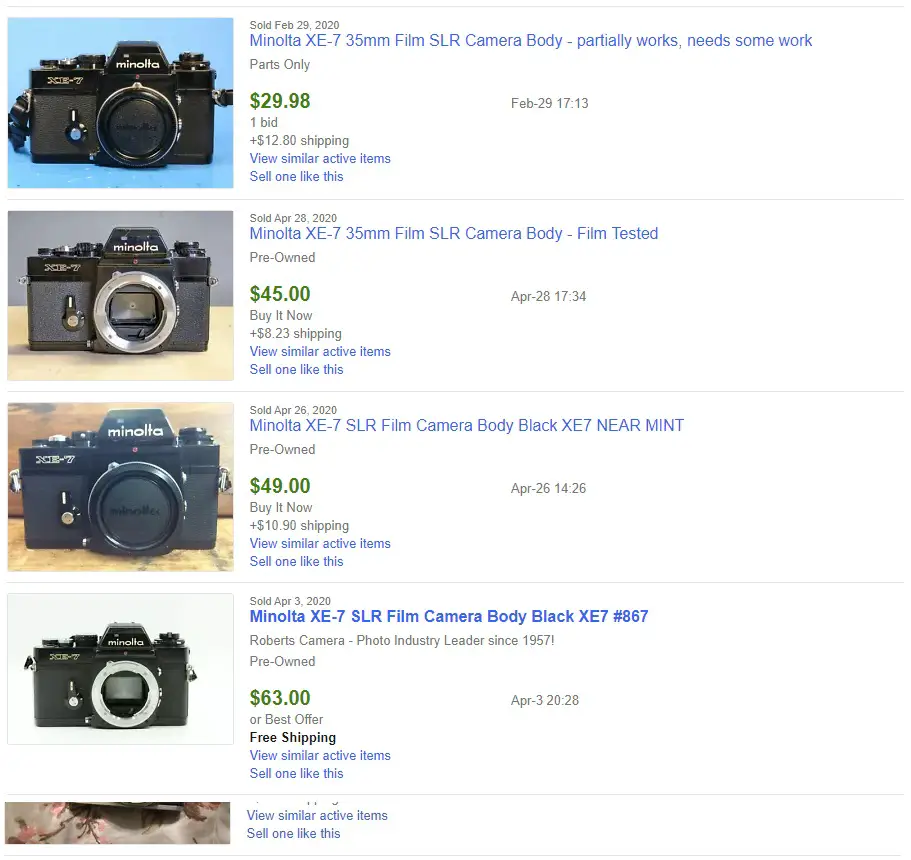
I would have compared a Nikkormat EL against the Minolta XE-7, since they were contemporary competitors in the 35mm AE SLR category. That said, this has been an interesting comparison between two camera design philosophies. I owned a Nikkormat EL and found it to work just fine as a step up from Ye Olde Nikkormat FTN.
Still, when the Nikon FM arrived, I put the EL aside, since I was moving away from “one manual shutter speed plus B” battery-dependent cameras when possible. I also found that Shutter Speed Priority AE found in the Canon EF was more interesting. Being able to see both shutter speed and aperture displays is a step beyond the “f/stop periscope” of 1970’s camera designs.
I agree, the Nikkormat EL is more of a direct feature for feature comparison with the XE-7 and while I do own an EL, this showdown was meant to compare my two favorite cameras, even if they’re not perfect matches for each other. Despite the similarities between the EL and EL2, I find the viewfinder better and support for AIs lenses more appealing to me.
And despite the odds being somewhat stacked against the XE-7 as its a 3+ year older camera, the fact that it was as close as it was, is a testament to how good of a camera it is.
If I ever find an XE-7 that works, I might like it fine. As it is I love my EL-2 to bits, I actually bought another as a back-up.
A close call, Mike. Given the choice between the two, it would come down aperture read-out in the Minolta or the SBC metering cell in the Nikon. SBC metering is so much better overall than cds, my various Gossen meters will attest to this, but I feel somehow lost when I can’t see the aperture. I’m sure in fast changing lighting scenes I could have lost out with potentially inaccurate readings from Minolta’s cds metering, but I have to say it was never an issue, whereas not having to remove the camera from my eye to vary the aperture is something that in actual use for me is far more useful.
Regarding the vignetting you report with the Minolta’s screen, I wonder if this could be caused by the size of the reflex mirror? I presently own two Minolta reflexes, the XD-7 and the SR-T Super, and neither has any edge dimming of the screen. The reasom I raise this point is that referencing the Super, it’s known that Minolta fitted it with an oversize mirror to compensate for this very isssue with tele lenses. Given its position in Minolta’s hierachy when the XE-7 was launched it woild be surprising if they used a “standard” sized mirror. But you never know.
Perhaps a better choice would be the Minolta XD-7/11 that was introduced in 1977. While it did not have mirror lockup, it did have shutter priority and could handle a motor drive. If you had used a true contemporary you might have come to a different conclusion.
And now I want both 🙁
What a difference 1 year makes in price…..
Like Patric, I had a Nikkormat Ftn in 1970, (still have one in fact) and moved up to the much more expensive EL in 1972 after a brief fling with an unreliable Nikon F and the Photomic finder. The EL was one of my favourite cameras although it felt a bit “soft” after the hard edges of the Ftn. Anyone with an early Nikkormat will know what I mean. I still have an F4s and an Fm2a titanium, as well as it’s modern equivalent digital the FX. Any of these cameras are so reliable I would have no hesitation in buying one today. In 1975 I sold the EL to fund buying a Kawasaki so that was that, it was too much money to keep, though I loved it.